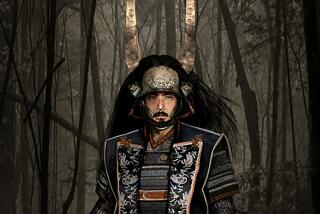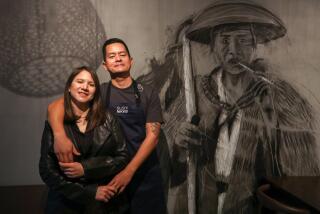Refashioning a Look Made In Japan
- Share via
It is said that the kimono takes its grace and beauty from the person who wears it.
That’s fine in Japan, where the robes are revered as an ancient and classic centerpiece of national dress. But here in the West, the kimono is subject to many interpretations: Do you drape yourself in it for a fancy party? Dismantle it to make an evening purse? Hang it on a living room wall? Wrap it carefully in rice paper and bring it out to show treasured guests?
All of the above, said Yoko Noboru, wife of the Japanese consul general in Los Angeles. “We wouldn’t be upset. We think it’s a wonderful idea. Many people alter kimonos, and if you do it nicely, it would be very appropriate. If you don’t use it, it is worthless. “
A growing number of clothing designers--some of them second- or third-generation Japanese Americans--are indeed incorporating the sometimes delicate garments into everything from jackets and pantsuits to vests and evening dresses. And customers can’t seem to get enough of them.
“Right now, I’m completely sold out,” said Renko Watanabe, who owns Renko, an upscale Redondo Beach boutique that carries kimono fashions, priced from about $160 for a skirt to $320 for a dress, along with classic evening wear. Her bestsellers include vests and jackets that combine kimono fragments with antique lace.
On the second floor of the Yaohan Plaza in Little Tokyo, June Aochi Berk’s small boutique also specializes in kimono-accented clothes. Prices run from $30 for a casual top to $600 for a traditional Japanese wedding coat. She also sells antique kimonos.
Kanojo (which means “girlfriend” or “she” in Japanese), an Irvine-based family business, operates stores in Torrance, Sacramento and San Jose and supplies clothing to 14 other stores in Hawaii, said co-founder Eileen Tabata Fitzpatrick.
“We use antique kimonos,” Fitzpatrick said. “But we cut them up and stylize them so they look very modern.” With designs in sizes 0 to 18, and prices at about $100 for a dress, Kanojo’s clientele has grown far beyond women of Japanese ancestry.
“By accident we became popular with mainstream America,” Fitzpatrick said. “That wasn’t our focus, but they’re finding us.”
Maria Hodgson of Los Angeles is an aficionado of kimono fashion. (In the ‘70s, her husband, James D. Hodgson, served as U.S. ambassador to Japan.) Besides several antique kimonos, she owns a stunning kimono-accented vest by Ann Namba, a renowned designer of kimono fashions who is based in Hawaii. First Lady Hillary Clinton owns a Namba.
Hodgson’s black vest is inlaid with panels from a hand-painted silk kimono in delicate shades of peach, yellow, silver, black, gray and gold. The buttons are mother-of-pearl.
The kimono has its origins in the 3rd century BC, said Noboru, who recently hosted a kimono fashion show at her Hancock Park residence. Initially, it was a simple garment with nothing but a hole for the head, but as time passed the Japanese added sleeves and other modern accouterments. In the 10th century, when court emperors gained power, Lady Murasaki Shikibu, who wrote the “Tale of Genji,” probably the world’s first novel, was known for wearing 12-layer kimonos.
Today, the royals still wear them. But so do plebeians. Classic kimonos feature Japanese flowers such as cherry and plum blossoms, camellias, peonies, irises and chrysanthemums. Abstract fans, streams, flower carts and bamboo are also traditional. Fabrics include silk, wool cotton and linen.
Noboru recounted the story of a Japanese woman who took her granddaughter shopping for a classic kimono. Instead, the little girl insisted on a contemporary $200 kimono featuring the Walt Disney character Bambi. Grandmother capitulated.
Explained Noboru: “Throughout history, styles have changed. And what we are seeing today is one more manifestation as people try to make a new wave of kimono fashion.”






